
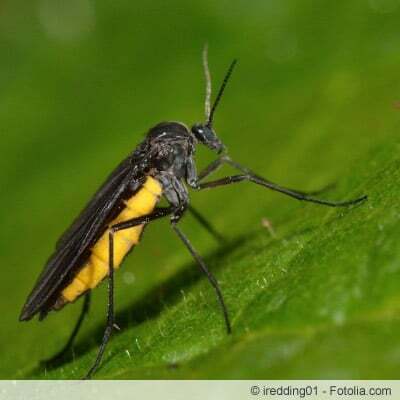
Table of contents
- Matches as an immediate measure
- Add quartz sand layer
- nematodes
- predatory mites
- Mosquito free
- Proven home remedies
- Chemicals
- preventive measures
- Disinfect substrate
- Mulch with sand
- prefer hydroponics
- carnivores
- Conclusion
Small black flies cavorting in the potting soil puts the hobby gardener on high alert. As a rule, fungus gnats have made themselves comfortable in the substrate in order to lay their eggs here. The larvae extract valuable nutrients from the soil and nibble at the roots, putting the plant under severe threat. Only rarely is it an infestation by fruit flies. This insect species looks confusingly like fungus gnats, but it is after ripe fruit. Bring your knowledge up to date here about the remedies that are effective against the plague.
Matches as an immediate measure
If you discover the first specimens of fungus gnats buzzing about the potting soil, an immediate countermeasure prevents an explosive spread of the brood. Without further ado, stick a few matches upside down into the substrate. The released sulfur kills the larvae immediately. In addition, the adult mosquitoes are prevented from laying eggs again. Replace the matches every 2 days as the small amount of sulfur is quickly consumed.
Tip:
Yellow stickers provide more information about the infestation pressure, as the adult fungus gnats stick to the glued boards. If a yellow sticky trap is littered with the 2-4 mm small, black dipterans, matches are no longer enough to combat it.
Add quartz sand layer
The tiny flies and their larvae feel particularly at home in the moist environment of potting soil. Since letting the substrate dry out is out of the question, the following strategy fixes the problem:
- Repot the plant infested with fungus gnats
- Remove the infected substrate from the roots as much as possible
- Ideally, rinse the root ball with lukewarm water
- Plant up to two thirds of the pot height in fresh, disinfected substrate
- Add a 0.5 to 1 cm thick layer of quartz sand
- Spread the rest of the substrate on top
The quartz sand acts as a barrier for the voracious larvae. If you water the plant from below from now on, the upper substrate layer can remain very dry, so that it is no longer suitable as a nesting place for fungus gnats.
nematodes
Nematodes have earned a good reputation in ecological pest control. These are tiny roundworms that cannot be seen with the naked eye. SF nematodes of the species Steinernema feltiae are wild about the larvae of fungus gnats. The nematodes invade the brood to deliver a deadly bacterium. How to use the remedy:
- Put the nematodes supplied in clay mineral in water according to the instructions
- Water the affected potting soil with the mixture
- Observe the minimum temperature of 12 degrees Celsius
- Do not use in direct sunlight
Subsequently, the plant can be watered and fertilized organically or minerally according to the normal care protocol. Only the administration of lime affects the effectiveness of nematodes.
predatory mites
When dealing with a hardened generation of fungus gnats, the nematodes get reinforcements in the form of predatory mites. Especially with the species Hypoaspis miles, the larvae are at the top of the prey list. The little predators go through a few stages of development first, so they don't appear as immediate as nematodes. The mites make up for this disadvantage by actively hunting down the pests for many weeks. This is how the application works:
- Predatory mites are delivered in an envelope with a peat-vermiculite mixture
- On the day of delivery, moisten kitchen paper and spread the predatory mites on it
- Spread the granules with the mites on the potting soil from the kitchen paper
- Do not incorporate the beneficial insects into the substrate
Leave the damp kitchen paper in the pot until the next day so that the remaining mites can migrate to the plant. In optimal conditions of 18 to 25 degrees Celsius, they keep the soil slightly moist.
Mosquito free
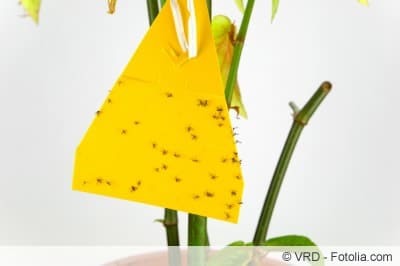
In the biological fight against mosquitoes, a bacterium is used that does not spare the larvae of fungus gnats. The Bacillus thuringiensis israelensis concentrates solely on the brood and leaves the plant undisturbed. In addition, it is harmless to humans, pets or beneficial insects.
Proven home remedies
Environmentally and health-conscious hobby gardeners favor the use of traditional home remedies in the event of a pest infestation in the early stages. In order to effectively control fungus gnats and fruit flies in potting soil, the following approaches can be considered:
- Enrich the irrigation water with 20 drops of tea tree or lavender oil per liter
- Sprinkle the potting soil with cinnamon or baking powder
- Stick garlic cloves into the infected substrate
Troubled gardeners cover the pot up to the root neck of the plant with a nylon stocking, which is closed as tightly as possible. In this way, the mosquitoes can no longer get to the potting soil and hatched larvae cannot escape. The escalating cycle of reproduction is thus interrupted. However, this measure takes 5-6 weeks, in which you have the unadorned appearance of an ornamental plant in mind.
Chemicals
Although fungus gnats do not pose a threat to human health, an infestation of potted plants in the room, Winter garden, greenhouse and on the balcony great discomfort, when at the slightest shake clouds of pests erupt from the raise potting soil. If all natural control methods are in vain, insecticides offer the last resort. These preparations will get rid of the plague:
- Insect-free Neem by Compo
- Pest-free Lizetan AZ from Bayer
- Organic pest-free neem from Bayer
- Organic Pest Free Neem by Natures
All preparations act on the basis of azadirachtin, a chemical compound with the main component from the seeds of the neem tree. Please apply these insecticides strictly as directed, especially indoors.
preventive measures
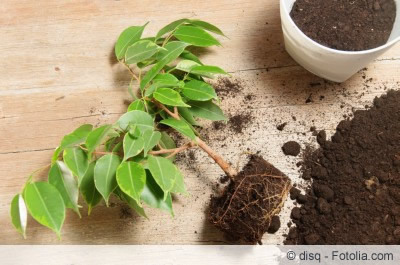
You can take the following precautions in advance to ensure that fungus gnats do not attack the potting soil of your plants in the first place:
Disinfect substrate
Despite the manufacturer's promises on the packaging, commercially available potting soil can very well already be infested with eggs and larvae of fungus gnats and fruit flies. Play it safe by converting the oven into a sterilizer. That is how it goes:
- Pour the potting soil into a fireproof bowl
- Put the lid on loosely
- Heat in the oven at 150 degrees for 30 minutes
Place smaller amounts of substrate in the microwave for 10 minutes at 800 watts. Also treat your own mixtures according to these instructions to ensure that there are no pests in them.
Tip:
The sowing and cutting propagation is explicitly threatened by insatiable larvae. Therefore, subject each growing soil to meticulous disinfection in the oven or microwave.
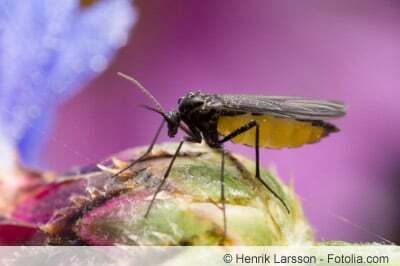
Mulch with sand
To prevent the female insects from getting to the potting soil, cover the surface with a 1 centimeter thick layer of quartz sand. To avoid having to replace the sandy mulch after each watering, water the plant from below. To do this, place the pot in a bowl with a water level several centimeters high for a few minutes. Due to the capillary force, the water is drawn up into the root ball so that the surface can remain dry.
prefer hydroponics
Almost all indoor and container plants are suitable for hydroponics. With this variant, the plant thrives in an inorganic substrate, such as expanded clay or seramis and water. Since no soil is used, fungus gnats and fruit flies have no chance to settle here and lay their eggs. However, since the switch from potting soil to hydroponics is not always successful, hydroponics should be favored when purchasing young plants.
carnivores
The use of carnivorous plants has proven to be extremely effective in keeping fungus gnats and fruit flies away. If you place at least 1 carnivore per windowsill, there is a good chance that the potting soil of the neighboring houseplants will remain free of pest infestation.
Conclusion
The next time a swarm of tiny insects emerges from the potting soil, you are now prepared to put a stop to the nefarious activity. The remedies against fungus gnats and their larvae presented here have proven to be excellent for freeing a besieged plant in good time before it suffers significant damage. If you follow the recommended prevention methods, you don't even have to bother with combating it. Usually it is not a question of fruit flies. Although these insects look confusingly similar to fungus gnats, they do not benefit from potting soil.
 garden editorial
garden editorial I write about everything that interests me in my garden.
Learn more about plant pests

White spots on leaves: what to do?
Whether in the home or in the garden, white spots on the leaves of your favorite plants are always a cause for concern. However, the causes can often be eliminated quickly. This guide summarizes the most common triggers and gives tips for quick help.

Cherry laurel has yellow eaten leaves: what to do?
Despite the robust nature of Prunus laurocerasus, it is occasionally attacked by pests and fungi. An infestation can be recognized by feeding damage and the discoloration of the leaves to yellow. You can find out how to combat and prevent the accumulation here.

Fighting grubs | Protect raised bed & lawn
Larvae of various species of beetles, grubs, can do a lot of damage in the garden. They live in the ground for several years and prefer to feed on roots. We present effective methods to combat the voracious pest or to effectively prevent an infestation.

Worms in cherries - 8 tips against maggots in cherries?
Worms in sweet cherries can spoil your appetite. It is a major nuisance when the entire cherry crop is affected. With these tricks you can contain the pest infestation and ensure that the insects do not multiply any further.
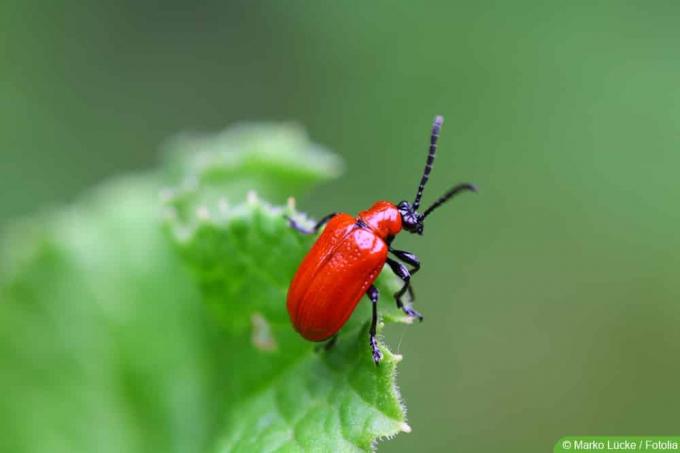
Fighting lily beetle - 11 effective home remedies
Lilies in the garden are beautiful to look at. There are the greatest types and varieties, all of which somehow have something special. Lily lovers can draw from the abundance of offers and look forward to the floral splendor. Lilies are actually quite hardy. There are few diseases and pests that can cause damage. However, the lily chicken can spoil the splendor.

Combating fungal infestation on trees: how to remove tree fungi
A tree fungus does not appear threatening, sometimes it is even interesting to look at. But that is deceptive. What we see is only the fruiting body, the mycelium is deep in the wood and destroys it slowly but purposefully. Eventually it kills the strongest tree.
